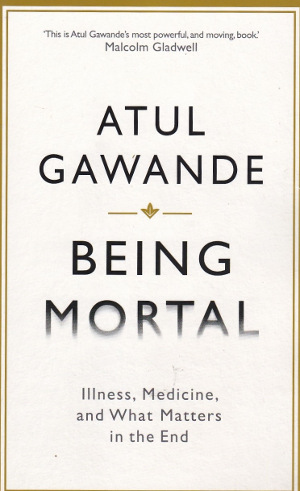Book Review - Reviewed by Robin Osborne
Being Mortal
Atul Gawande
(Profile Books 282 pp)
In an earlier review I described Atul Gawande’s The Checkist Manifesto as required reading for those in the medical profession or any line of work that entails identified outcomes, team work and the serious consequences, professional or financial, of error.
The same may be said of this discussion of end-of-life issues, which he encapsulates in the sub-title, ‘Illness, Medicine, and What Matters in the End.’
Dr Gawande explains, “This is a book about the modern experience of mortality – about what it’s like to be creatures who age and die, how medicine has changed the experience and how it hasn’t, where our ideas about how to deal with our finitude have got the reality wrong.”
The backdrop is that, “no single disease leads to the end; the culprit is just the accumulated crumbling of one’s bodily systems while medicine carries out its maintenance measures and patch jobs… The curve of life becomes a long, slow fade.”
He describes this process as One Damn Thing After Another, the ‘ODTAA syndrome’ wherein the “pauses between crises can vary. But after a certain point, the direction of travel becomes clear.”
Dr Gawande is a modern-day medical superstar, born of Indian immigrant doctor parents, a practising surgeon in Boston, Harvard professor, contributor to a wide range of journals, including The New Yorker, and well published author.
He could be forgiven for resting on his laurels, but there’s no sign of slowing up, and this latest effort taps into a key debate of our time - how should, and can, society care for the ageing population?
Getting straight to the point, he writes, “People live longer and better than at any other time in history. But scientific advances have turned the processes of ageing and dying into medical experiences, matters to be managed by health care professionals. And we in the medical profession have proved alarmingly unprepared for it.”
Moreover, as he adds, “This reality has been largely hidden, as the final phases of life become less familiar to people.”
In the mid-20th century, most deaths occurred at home, while only 17 per cent did by the 1980s. This is changing again, with 45 per cent of Americans dying in hospice care, more than half of these at home.
The reason, he suggests, is that countries go through three stages of medical development that parallel their economic situation: those living in poverty mostly die at home, those in improved circumstances can turn to health care systems for support, while at the third stage, as incomes climb to the highest levels, “people have the means to become concerned about the quality of their lives, even in sickness, and deaths at home actually rise again.”
The changing pattern of how we manage the last days - months, or years - of our older citizens’ lives has taxed the author’s mind for some time, fuelled by his interactions with seriously ill (but not always terminal) patients, and, in the most personal part of this book, by the passing of his beloved father.
Diagnosed with an advanced spinal tumour, Dr Gawande Snr received disparate advice from two leading surgeons. One advocated urgent intervention, to be followed by extensive follow-up treatment and rehab, the other a ‘wait and watch’ approach that would eventually lead to surgery but in the meantime provide a better quality of life.
Dr Gawande Jr, along with the patient and family members, supported the latter course, wisely as it turned out.
His father continued operating for some time, enjoyed his “chapatis, rice and split-pea dal”, sorted through photos, advised the Rotary chapter he had led for years, and worked on the village healthcare foundation he had established back in India.
“The medicine did a good job of preventing pain,” his son recalls. “What he wanted for the final lines of his story, now that nature was pressing its limits, was peacefulness.”
Addressing the issue of assisted death, Gawande writes that, “Certainly, suffering at the end of life is sometimes unavoidable and unbearable, and helping people end their misery may be necessary.
“But we damage entire societies if we let providing this capability divert us from improving the lives of the ill. Assisted living is far harder than assisted death, but its possibilities are far greater, as well.”
He raises a major concern about the lack of geriatricians, both now and even more so in the future when they will be increasingly needed, advocating that all primary care doctors and nurses be upskilled in caring for the very old.
Quoting one such specialist, he says, “We’ve got to do something. Life for older people can be better than is it today.”
If there’s one key message from this excellent and timely book, this is it.
















